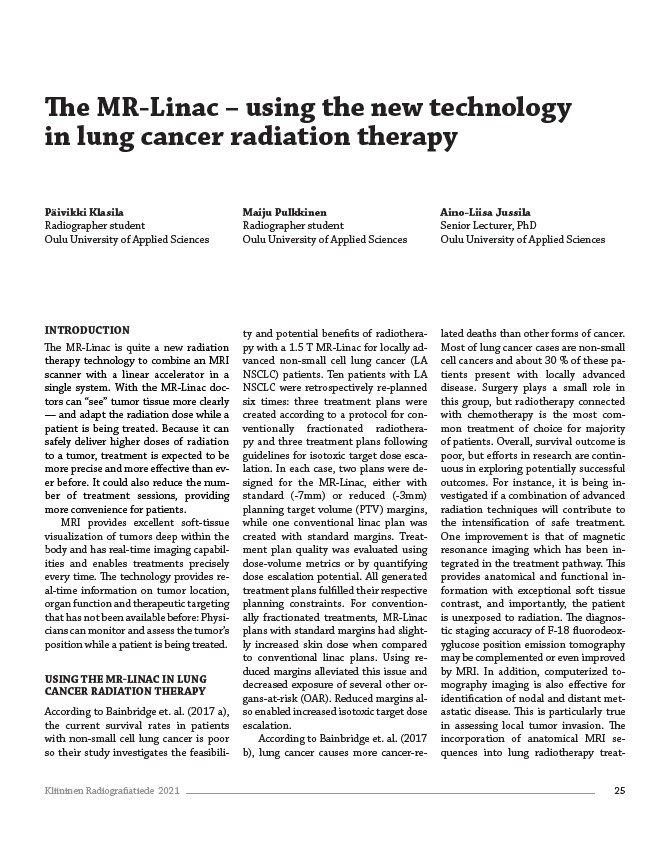
The MR-Linac – using the new technology
in lung cancer radiation therapy
Päivikki Klasila
Radiographer student
Oulu University of Applied Sciences
INTRODUCTION
The MR-Linac is quite a new radiation
therapy technology to combine an MRI
scanner with a linear accelerator in a
single system. With the MR-Linac doc-tors
can “see” tumor tissue more clearly
— and adapt the radiation dose while a
patient is being treated. Because it can
safely deliver higher doses of radiation
to a tumor, treatment is expected to be
more precise and more effective than ev-er
before. It could also reduce the num-ber
of treatment sessions, providing
more convenience for patients.
MRI provides excellent soft-tissue
visualization of tumors deep within the
body and has real-time imaging capabil-ities
and enables treatments precisely
every time. The technology provides re-al-
time information on tumor location,
organ function and therapeutic targeting
that has not been available before: Physi-cians
can monitor and assess the tumor’s
position while a patient is being treated.
USING THE MR-LINAC IN LUNG
CANCER RADIATION THERAPY
According to Bainbridge et. al. (2017 a),
the current survival rates in patients
with non-small cell lung cancer is poor
so their study investigates the feasibili-ty
Maiju Pulkkinen
Radiographer student
Oulu University of Applied Sciences
and potential benefits of radiothera-py
with a 1.5 T MR-Linac for locally ad-vanced
non-small cell lung cancer (LA
NSCLC) patients. Ten patients with LA
NSCLC were retrospectively re-planned
six times: three treatment plans were
created according to a protocol for con-ventionally
fractionated radiothera-py
and three treatment plans following
guidelines for isotoxic target dose esca-lation.
In each case, two plans were de-signed
for the MR-Linac, either with
standard (-7mm) or reduced (-3mm)
planning target volume (PTV) margins,
while one conventional linac plan was
created with standard margins. Treat-ment
plan quality was evaluated using
dose-volume metrics or by quantifying
dose escalation potential. All generated
treatment plans fulfilled their respective
planning constraints. For convention-ally
fractionated treatments, MR-Linac
plans with standard margins had slight-ly
increased skin dose when compared
to conventional linac plans. Using re-duced
margins alleviated this issue and
decreased exposure of several other or-gans-
at-risk (OAR). Reduced margins al-so
enabled increased isotoxic target dose
escalation.
According to Bainbridge et. al. (2017
b), lung cancer causes more cancer-re-lated
Aino-Liisa Jussila
Senior Lecturer, PhD
Oulu University of Applied Sciences
deaths than other forms of cancer.
Most of lung cancer cases are non-small
cell cancers and about 30 % of these pa-tients
present with locally advanced
disease. Surgery plays a small role in
this group, but radiotherapy connected
with chemotherapy is the most com-mon
treatment of choice for majority
of patients. Overall, survival outcome is
poor, but efforts in research are contin-uous
in exploring potentially successful
outcomes. For instance, it is being in-vestigated
if a combination of advanced
radiation techniques will contribute to
the intensification of safe treatment.
One improvement is that of magnetic
resonance imaging which has been in-tegrated
in the treatment pathway. This
provides anatomical and functional in-formation
with exceptional soft tissue
contrast, and importantly, the patient
is unexposed to radiation. The diagnos-tic
staging accuracy of F-18 fluorodeox-yglucose
position emission tomography
may be complemented or even improved
by MRI. In addition, computerized to-mography
imaging is also effective for
identification of nodal and distant met-astatic
disease. This is particularly true
in assessing local tumor invasion. The
incorporation of anatomical MRI se-quences
into lung radiotherapy treat-
Kliininen Radiografiatiede 2021 25